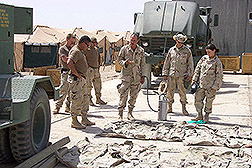This page has been archived and is being provided for reference purposes only. The page is no longer being updated, and therefore, links on the page may be invalid.
|
Read the magazine story to find out more. |
|
|
Partnership Supports Troops With New Insect Control Measures
By Jim CoreSeptember 6, 2005
New, high-tech fabrics that repel insects are one technology being developed by Agricultural Research Service (ARS) scientists as part of ongoing, cooperative research with the U.S. Department of Defense (DOD) to protect troops from insect-transmitted diseases.
Since ARS began working with DOD in the 1940s, its scientists have made a number of discoveries to support the military. They invented the aerosol spray canister--dubbed the "bug bomb"--to dispense insecticides, and they tested and reported the repellent properties of DEET. ARS researchers also developed ultra-low-volume fogging equipment, and led the development of permethrin-treated military uniforms and bed nets that repel ticks and kill disease-carrying mosquitoes.
Recently, ARS partnered with DOD in an initiative called "Deployed War-Fighter Protection Against Disease-Carrying Insects", which is composed of several projects at five locations across the nation. The initiative's current emphasis is on identifying and testing new classes of pesticides, new tools for applying pesticides in military environments, and new methods for personal protection from insect vectors.
At the ARS Center for Medical, Agricultural and Veterinary Entomology (CMAVE) in Gainesville, Fla., and at the Chemicals Affecting Insect Behavior Laboratory (CAIBL) in Beltsville, Md., ARS scientists and their cooperators are developing sophisticated modeling methods for selecting promising insecticide candidates from thousands of compounds.
At CAIBL, chemist James E. Oliver is leading an effort to develop fabrics with permanently incorporated repellent properties in their molecular structures. Entomologists Mat Pound and Kim Lohmeyer at ARS' Knipling-Bushland U.S. Livestock Insects Research Laboratory in Kerrville, Texas, are working to reformulate the current pyrethroid treatment used by the military so it will be effective beyond the current 10 to 15 washings. At CMAVE, chemist Ulrich Bernier and an industrial partner plan to infuse fabric with non-pyrethroid chemicals.
Ronald J. Nachman, a chemist with the ARS Southern Plains Agricultural Research Center at College Station, Texas, is leading a project to create agents that remain active for long periods in house fly and filth fly breeding locations.
Read more about the research in the September 2005 issue of Agricultural Research magazine.
ARS is the U.S. Department of Agriculture's chief in-house scientific research agency.


